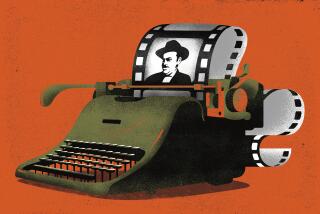A ‘Don Quixote’ Crusade : Orson Welles’ Mythic Film Finally Pieced Together
- Share via
SEVILLE, Spain — Orson Welles began shooting his film version of “Don Quixote” in 1955, and was reportedly so obsessed with the project that he was still talking about finishing it four months before he died in 1985.
The film was completed--although Welles never lived to see it--but with almost as much struggle and controversy as the director received during his filmmaking career.
Spanish film distributor Patxi Irigoyen has produced “Don Quijote” (Spanish spelling) by Orson Welles, a 116-minute, 35-mm film edited from about 328,080 feet of film footage the producer found and restored after an 18-month search across two continents.
“I had always heard about the ‘myth,’ of Welles’ ‘Don Quixote,’ with everyone telling me how impossible it would be to try and locate its footage,” said Irigoyen, interviewed at his office at the Universal Exposition here.
“I decided to begin my search for the footage around the end of 1989, and every step of production has been difficult,” said Irigoyen, a first-time producer and founding partner of El Silencio, an independent production company that produced the film.
The Spanish-language version of the film premiered at the Universal Exposition on April 20 and was screened May 16 at Cannes, where it received mixed reviews. It was shown again at the Exposition site May 21. Irigoyen said he is now restoring the film for an English-language version that features a narration by Welles--Spanish actor Constantino Romero dubbed the Spanish narration--which, he says, will be shown to distributors beginning this week.
Irigoyen’s $3-million film, based on Spanish writer Miguel de Cervantes’ 17th-Century classic novel, sets Don Quixote, an old man who believes he is a knight-errant, and his peasant squire, Sancho Panza, in modern-day Spain, where they are in conflict with the people and technological innovations they encounter. The film also includes scenes with Welles and his camera crew.
According to Welles’ biographer, Frank Brady, Welles began shooting “Don Quixote” as a 30-minute CBS-TV drama in 1955. The network withdrew its support when a CBS representative screened a portion of the unedited film and was dissatisfied, Brady says.
“ ‘Don Quixote’ was a radical departure from the classical film style seen on television in those days or even today,” said Brady, in a telephone interview. Brady said Welles continued shooting during the next 14 years in Mexico, Spain and Italy, reassembling his cast and crew whenever he could raise the finances, a production technique Welles used on other projects, notably “Othello,” which took four years to complete.
“Orson seriously said he was going to title the film, ‘When Are You Going to Finish Don Quixote,’ because every single person who interviewed him for the last 20 years of his life asked him that question,” said Brady, who also teaches contemporary cinema at St. John’s University in New York.
Production of the film was further aggravated by the fact that its star, Francisco Reiguera (Don Quixote), was not allowed to enter Spain at will because he was a Republican exile of the Spanish Civil War living in Mexico. Welles outlived Reiguera as well as supporting actor Akim Tamiroff, who portrayed Panza.
When Irigoyen began his search, he knew film director Costa-Gavras had edited a 40-minute version of Welles’ film under the auspices of the Cinematheque Francaise. But he was aware additional footage was rumored to exist.
In early 1990, Irigoyen contacted Yugoslav actress Oja Kodar, who had inherited the rights to Welles’ uncompleted film works, and purchased the rights to “Don Quixote.”
Kodar led Irigoyen to 30,000 meters of footage that had not been recovered before and 10,000 meters that had never been printed by Welles that were in the possession of French-Canadian actress Suzanne Cloutier, as well as some of Welles’ friends and associates in the United States.
Irigoyen said he is convinced he has located all the footage Welles shot for “Don Quixote,” minus one scene depicting Don Quixote attacking a film screen.
The missing scene caused a controversy in March, when Italian film editor Mauro Bonnani asked organizers to halt the film’s premiere on the grounds that it did not include 20,000 meters of footage in his possession. Bonnani was unwilling to release the footage and is embroiled in a lawsuit with Irigoyen and Kodar over the rights of ownership and use.
Irigoyen and the film’s editor, Jess Franco, have also faced technical problems in producing the film. Irigoyen cleaned, processed and restored the footage--Welles had shot on 35-millimeter, 16mm and super-16mm black-and-white film--at the ARRI and TV-1 film and video laboratories in Munich.
They both said the Spanish-language copy of the film contains several contrast and resolution deficiencies. “The film is only 80% of what it could be in terms of visual quality of its images,” said Franco, a Spanish director who worked as second unit director for Welles on “Chimes at Midnight.” “We hope to improve it another 5-to-10% with further restoration efforts at the Geier film and video laboratory in Munich.”
“Structuring the film was another problem,” Irigoyen said of the arduous editing process, “because we would get some film footage here, and some more there, and not know how to put them together until another piece of footage that linked the two showed up a few days later.”
Irigoyen said Welles originally shot the film without a script or a soundtrack of the actors. Welles did record a one-hour soundtrack in which he read the narration and the lines of the two main characters. His soundtrack, along with notes Welles scribbled, helped guide Irigoyen and Franco.
Irigoyen said the additional 56-minutes of Spanish life scenes without narration were subsequently left to the editorial discretion of him and Franco.
“We’re not saying this is a Welles film because he did not complete it. I’m certain that if Welles were to see this film today, he would not even like some parts and want to change them,” said Irigoyen.
Irigoyen noted the coincidence of having produced the film in the country for which Welles had a deep fondness and chose as his final resting place.
“We had to do this project because ‘Don Quixote’ was so special to Welles. He pursued it for so many years of his life, and it would be a loss if all this footage were to have lain around undiscovered, wasting away for no one to ever see.”
More to Read
Only good movies
Get the Indie Focus newsletter, Mark Olsen's weekly guide to the world of cinema.
You may occasionally receive promotional content from the Los Angeles Times.









